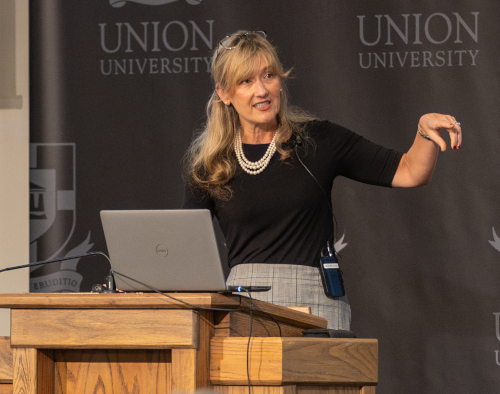JACKSON, Tenn. — Oct. 8, 2025 — Think of Appomattox as a starting place rather than an ending point, Caroline Janney told a group of Union University students and Jackson community members Oct. 6 in the G.M. Savage Memorial Chapel.
“Indeed, there are as many stories that begin in Appomattox as there were men there: Union and Confederate, black and white,” said Janney, the John L. Nau III Professor of the American Civil War at the University of Virginia.
As the 28th annual Carls-Schwerdfeger Lecture Series speaker, Janney gave two addresses related to the American Civil War. The afternoon lecture was entitled, "When the Monuments Went Up: The Long Fight over Civil War Memory." The second and main lecture that evening was, "After Appomattox: Ending the Civil War."
“We want to bring in different perspectives from people who have areas of expertise that we don’t have,” said Keith Bates, chair of Union’s Department of History and lecture organizer. “That way, students can hear things that they wouldn’t hear from us in our classes, and we can continue to give back to the community. Universities aren’t just supposed to take care of what’s in-house; they’re supposed to have a presence in the broader community.”
During the evening lecture, Janney shared stories with that broader community, detailing the fates of multiple soldiers, most of them Confederate, as they attempted to journey home after Lee’s surrender to Grant at Appomattox Courthouse.
“For Grant, getting Lee’s soldiers home as quickly as possible was key to restoring peace, was key to restoring the Union and it was as practical as it was pragmatic,” Janney said.
She went on to debunk common misconceptions surrounding the Confederate surrender at Appomattox, including clarifying that the agreement between Grant and Lee was not a peace treaty. Instead, it was a formal military order declaring that all Confederate soldiers under Lee’s command had been captured by the Union army and would be considered paroled prisoners of war. These paroled prisoners were given papers allowing them to travel freely back to their homes, effectively demobilizing Lee’s entire army.
“Some kept to the roads, but others followed muddy ravines and hog trails and stream beds,” Janney said. “But some, with those passes in hand, headed to places like Brookville … the place with the closest working railroad.”
Janney outlined the journeys of specific Confederate soldiers and regiments, sharing how some were recaptured and terrorized by Union soldiers, some looted Southern towns and some tormented civilians and newly freed slaves on their way back home.
“We still live in a fallen, sinful world, so there’s sinful things all the time,” said Union senior Audrey Cooke, who attended the lecture. “War’s not pretty; war’s not fun. We shouldn’t be shying away from these aspects of history, even if it’s difficult.”
After recounting the homecomings of multiple soldiers and freed slaves, Janney concluded her lecture the way she started it: by inviting her audience to think more deeply about the Civil War and its lasting consequences. Specifically, she challenged them to look at Lee’s surrender at Appomattox as the start of a new era, not the end of an old one.
“Rather than serving as a clear ending to the war, the surrender at Appomattox … brought into stark light many of the legal, social and political questions that had plagued the war from its very beginning,” Janney said. “The disbanding of Lee's army had not marked the end of a nation's division. Indeed, it was only the beginning, foreshadowing much of what would play out in the decades, and perhaps even centuries, to come.”

